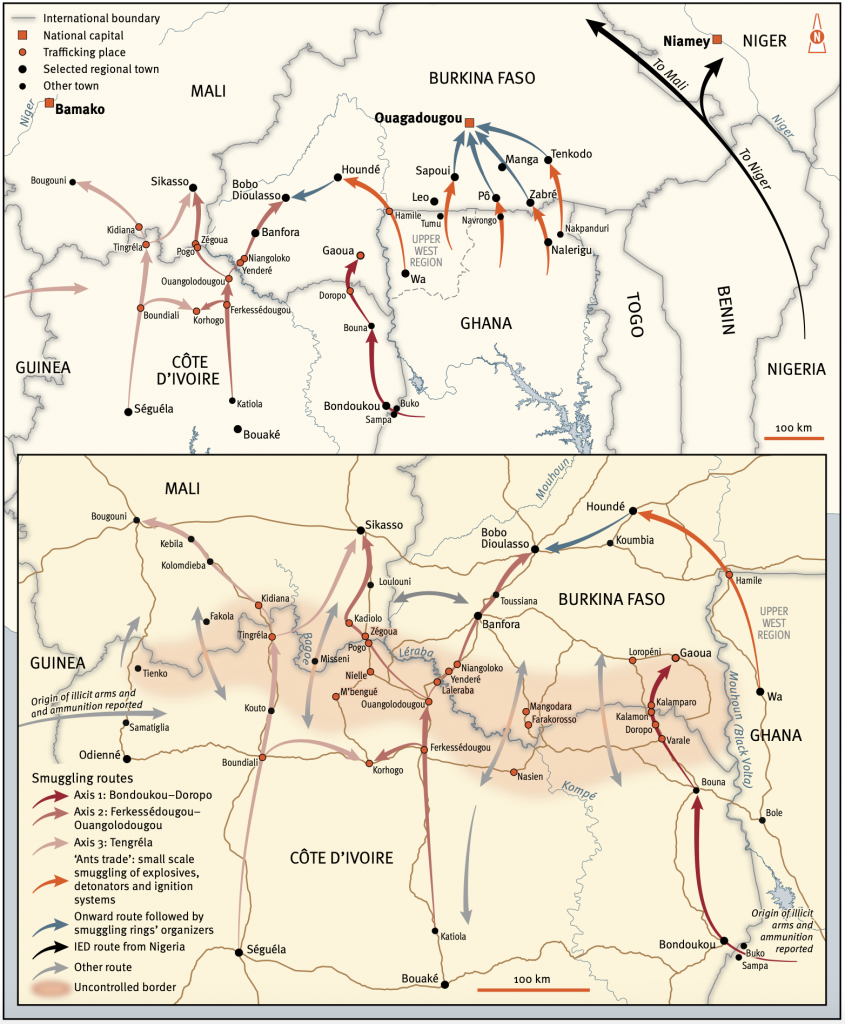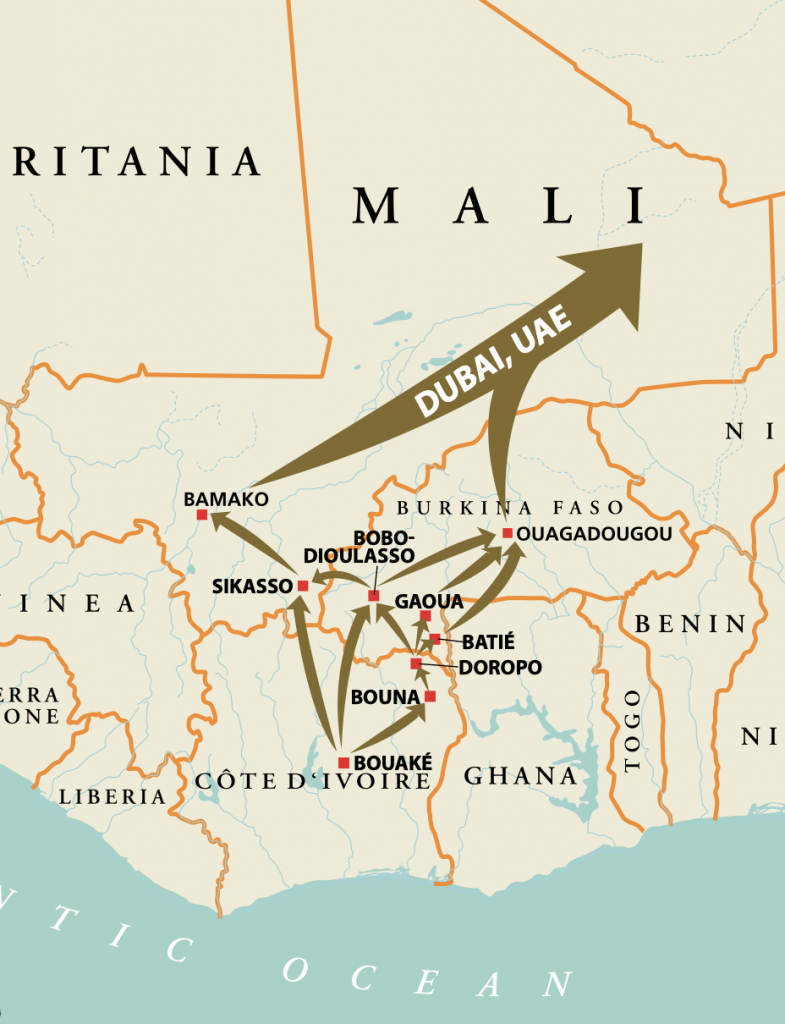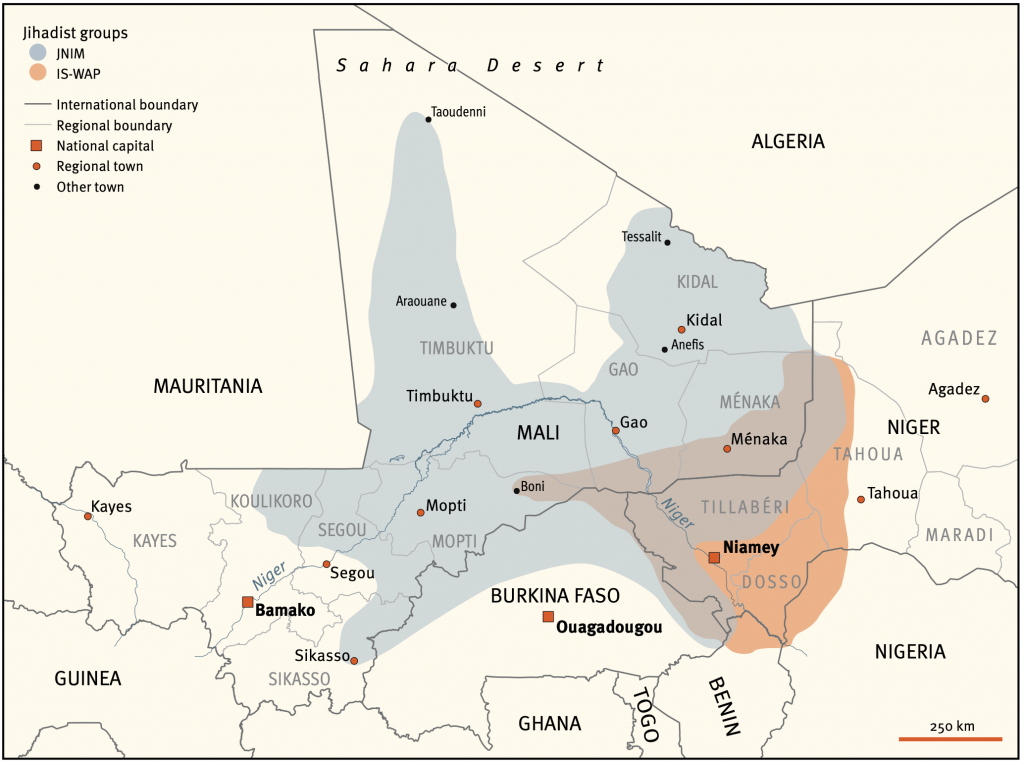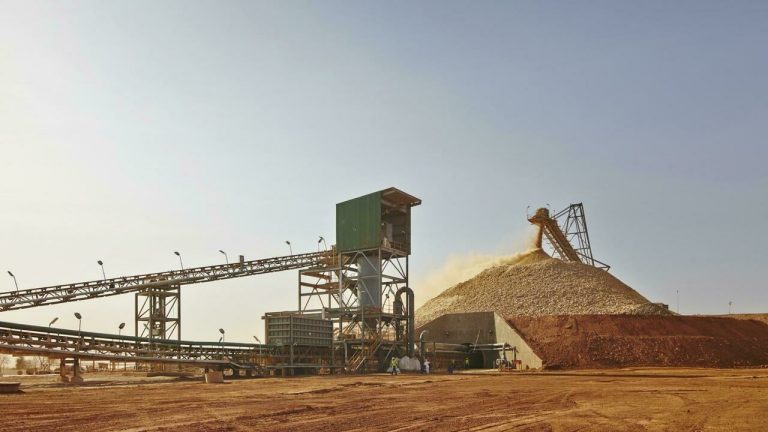For the past five years, terrorist groups have been controlling gold deposits in the areas of Burkina Faso where the government is virtually absent. They use this control as the method to sponsor their activity. Gold is used both to enrich individual combatants and to fund armed movements. Money transfer companies and non-profit organisations are the main channels used to finance terrorist attacks in Burkina Faso.
Burkina Faso is Africa’s fourth largest gold producer. The gold production volume in 2020 is approximately 93.4 tons according to Gold mine production, Gold.org. Currently, approximately $4.9 billion worth-gold produced in Burkina Faso annually makes mining a highly lucrative market, which has recently been attacked by jihadist and militant organizations seeking for the funds to finance their operations in the area.
Since 2016 jihadists have made $140 million from attacks on gold mines in Burkina Faso, according to a report commissioned by the government in 2020.
Gold mining has increasingly become vital to the economy of the landlocked West African country, which was once dependent on cotton exports for foreign earnings.
At the same time the gold industry has also become a welcome source of funding for jihadists and other armed movements in areas abandoned by the central authority, according to the report’s author Ollo Kambou of the Burkina Economic and Social Observatory (OES).
Despite national attempts to deter such groups from targeting the goldsector, Burkina Faso has continued to fall victim to attacks, highlighted by the tragic deaths of over 130 people in a gold mine attack on Friday, June 4, 2021. If jihadist and militant groups operating in the area are not effectively deterred from these attacks, they are very likely to increase in Burkina Faso, and spread to or increase in neighboring countries, particularly, Ghana, the Ivory Coast, Guinea, and Mauritania. Jihadist and militant operations will likely also expand in strength and influence in the region, posing a serious regional and continental threat.
As we claimed in November 2019, gold can become a new asset for both financing and recruitment. This risk is increased by the fact that gold miners sometimes do not consider the presence of jihadists as a threat but an opportunity.
Many jihadi militant groups using gold to fund terrorist activities have not been officially identified, though U.S. government officials blame the Islamic State in Greater Sahara (ISGS). The ISGS is a local branch of the Islamic State group (ISIS) and an affiliate of Al-Qaeda. It is based in Mali and Niger and operates along the Mali-Niger border while conducting attacks in Burkina Faso.[4] The jihadist activity involves military clashes, explosions, violence against civilians, and strategic developments. A 2017 attack on Nigerien and U.S. soldiers killed civilians and 4 U.S. military officials; these casualties alerted the United Nations Security Council (UNSC). The growth of this terrorist group implied their spread in Burkina Faso, where they targeted the gold industry. The increasing danger they pose to regional stability and their link to well-known ISIS make these extremists a great concern for intelligence authorities worldwide.
Easy smuggling, profitable revenues gained through foreign gold purchases and traceability difficulties have made gold an appealing source of terrorist funding. This is why Burkina Faso’s multiple gold mining centers across the entire country became a target. Growing security concerns in the country since 2015 have kept the government occupied with tackling the activity of local extremist groups; as a result, patrolling over mining centers has proven more difficult. Therefore, the almost unchallenged access to and manipulation of the gold-mining industry made it easier for ISGS to operate. Extortion through underpaid officials in the area is used to invade mining sites. Once gold is obtained, it can be easily exchanged due to its high intrinsic value and price in the commodity market for the purchase of weapons.
The smuggling of the artisanally mined gold from Burkina Faso happens due to the region’s porous borders.Terrorist organizations such as ISGS exploit the little control over cross-country borders to get commodities like gold out of the country and benefit from the higher revenues.
First, gold is smuggled into the neighboring country of Togo where gold imports face few border checks. Then gold is sold at Togo’s lower tax rates, thus creating a greater profit. Later, it is flown to the United Arab Emirates (UAE) through hand luggage on commercial flights. The country acts as a major trading hub receiving, processing and ‘laundering’ African gold.
According to the INTERPOL, OCGs tends to exploit African airlines and airports with low screening facilities to smuggle illicit goods. Because of ineffective control and probable corrupt elements, criminals can transport large amount of gold via commercial flights. Open sources analysis suggests that Central African airports (controlled by Russian PMCs) may constitute a hub for gold trafficking. After seizing 150 kg of gold in Dubai in the luggage of a smuggler flying from the DRC (Lubumbashi) to the UAE (Dubai) once a month by commercial airlines, the DRC GoE estimated that 3.6 tonnes could have been smuggled over the last two years by a single individual. In Cameroon, regular airlines are also used to transport gold: in August 2019, 60 kg of gold hidden in parcels containing passengers’ blankets were seized and a network composed of Asian, European, and African criminal was dismantled. Open sources reported that Cameroon’s authorities arrested two Canadians and a Cameroonian national who were about to smuggle 250 kg of gold to the UAE using a private jet. In the Great Lakes region, a report suggested that gold is primarily smuggled from the DRC “by helicopter or fixed-wing small aircraft to a landing strip in Uganda, Rwanda and Burundi.
More recently a Ndjamena-based Chadian trader tried to export 20.1 kg of gold in a fake bottomed suitcase and was arrested in Douala. In Gabon, a Malian national was arrested at the airport heading with 20 kg of gold in his luggage. In the three cases, the UAE or China was reportedly as the gold’s final destinations.
Then gold is sold at the Dubai Multi-Commodities Centre (DMCC) where it gets into the international gold flow. In 2016, the UAE imported $15.1 billion worth of gold from Africa alone. However, the amount imported in the UAE does not match the amount exported from African countries. It indicates the continued existence of fraudulent schemes which are traced back to illicit terrorist activity in Burkina Faso, specifically by ISGS. The profit made in Dubai, however, comes from the violent acts done against Burkina Faso’s civil society.

Gold is smuggled through illicit channels beginning in Burkina Faso and reaching Dubai as a final destination.
Solhan, a center of the gold-mining industry in Burkina Faso, was attacked by extremists on Friday, June 4, 2021, resulting in the deaths of over 130 people. As the deadliest attack in the country’s history, it highlights the danger posed to ordinary civilians working in the gold industry in the area. For Burkina Faso, the death toll indicates that large degree of violence gold’s profitability has the potential to generate. Continued gold mining in the country will likely result in continued violence, though stopping mining altogether has also repercussions. Halting the gold mining industry, or even significantly limiting it, will likely cause many artisanal miners to lose their primary source of income. Some miners may find new ways to earn for living, but others may resort to illicit activities out of desperation. Although unlikely, it is also possible that some artisanal miners may join the extremists attacking the gold mines. So far, the extremist activity that occurs throughout Burkina Faso’s gold mines has caused a disruption that has begun to uproot society through the fear, violence, and displacement that it entails.
There are three primary gold smuggling or trafficking axes in the tri-border area.

Bondoukou–Bouna–Varale–doropo route (axis 1). There are reports of artisanal and small-scale mining gold from Bouana and Doropo being smuggled into Burkina Faso on this route (UNSC, 2015; 2016; Martin and Helbig de Balzac, 2017).

During the FN rebellion’s occupation of northern Cote d’Ivoire, this axis was the main arms supply route for the north-east and the transit route for smuggling gold to Burkina Faso and cashew nuts to Ghana. The main route to avoid border controls passes by the Ivorian town of Kalamon, a hub for gold smuggling, and enters Burkina Faso at Kalamparo. The only marking of the border along this route is a milestone dating from the time of French colonial rule, and only the Burkinabé side has a fixed gendarmerie post positioned some 7 km from the actual border. The UN Group of Experts reported that vehicles belonging to notorious gold smugglers from Varale and Kalamon, with links to the extended families of Wattao and former Ivorian prime minister Guillaume Soro, are not checked when they pass through Kalamparo (UNSC, 2014b; 2015).
Ferkessédougou–ouangolodougou route (axis 2). This route splits into two: the first part heads for Burkina Faso (Ferkessédougou–Ouangolodougou– Laleraba (Cote d’Ivoire)–Yendéré (Burkina Faso)–Niangoloko–Banfora); the second part goes to Mali (Ferkessédougou–Ouangolodougou– Pogo–Zégoua (Mali)–Kadiolo– Sikasso). Customs and other state authorities are present at Laleraba and Pogo in Cote d’Ivoire, at Yendéré in Burkina Faso, and at Zégoua in Mali.
The Tengréla routes (axis 3). These routes cover the primary crossing area for illicit trafficking between Cote d’Ivoire and Mali. To the east of Tengréla, the Bagoe River marks the border. This river is easily passable either on foot or by dugout canoe. To the west, the border follows some seasonal streams, but effectively there is no natural barrier to prevent border crossings. As a result, this area features at least 13 crossing points, of which only two are official: at Nigoni and Débeté (UNSC, 2016).
The Tengréla routes are used to smuggle artisanal and small-scale gold mined along the Bagoe River into Mali.
Aside from the three main axes described, the Burkinabé town of Mangodara serves as part of a secondary smuggling route.
With a total population of approximately 20 million people, Burkina Faso’s 1 million artisanal gold miners make up 5% of the country’s population. Relative to the population size, a large percentage of people work in the artisanal gold mining sector, and they are at particular risk of being attacked due to the lack of protection involved in their work environment. The gold mining sector as a whole is vulnerable to consequences that impact wider society on a large scale. In the short term, gold mine attacks have led to displacement, unemployment, and increased financing of jihadist and extremist groups. In the long term, however, this trend becomes a dangerous cycle in which gold mine attacks will likely feed into a greater cycle of these factors.
Further gold mine attacks in Burkina Faso and neighboring countries are likely to contribute to a cycle of displacement, unemployment, and terrorist financing.


As of 2020, one of the top 10 largest gold mines in Africa is located in Burkina Faso, with an additional 6 gold mines located in the neighboring West African countries of Ghana, Mali, and Mauritania. Combined with the surge in jihadist activity in the region, particularly along the border between Burkina Faso and Mali, more attacks in the short term are likely. Gold is a major industry in the region, meaning that any disruption to the market will almost certainly have detrimental impacts within wider society. Ordinary nationals of Mali and Burkina Faso working in mines, along with their families, risk losing a primary source of income. Additionally, increased funding to jihadist and militant groups increases the likelihood of violence in the region, further destabilizing national governments and putting more people at risk. Jihadist and militant groups will likely see any success in the acquisition of significant quantities of gold as an encouragement to target more gold mines. If such activity continues undeterred, a spillover effect into other African countries, especially in the Sahel region or on the near coast is very likely. Other gold-producing countries like Ghana and Mauritania are at high risk for attack.
The current precious commodities’ trade framework lacks a track and trace system whereby gold purchases are processed and verified. Formal procedures to identify origin and value are mandatory, but no compliance action is expected because of undue administrative processing. Establishing stricter regulatory policies and enforcing compliance from interested parties such as local sellers and foreign buyers would likely deter fraudulent schemes from being set up, and properly legalize the gold trade, which is profitable for the country’s GDP. A clear regulatory framework would likely also incentivize foreign investors to trust their money in a sector with little entry cost and big returns.
The late Ivorian colonel and former comzone Issiaka Ouattara (also known as ‘Wattao’) held a monopoly on gold smuggling between Cote d’Ivoire and Burkina Faso. The profits from this commodities such as gold and diamonds, serve as alternative currencies in money- laundering schemes, while also financing terrorist organizations in West Africa (Martin and Helbig de Balzac, 2017, p. 3).
Gold mining is also linked to arms trafficking. Commercial hubs such as Bobo Dioulasso, Bamako, and Ouagadougou are areas of concentration for illicit transfers, where goods are stockpiled before being dispatched to the intended end users and where most of the capital fuelling the trafficking rings resides. Artisanal mining areas also generate high demand for illicit arms. The interviews and research have shown that even though smuggling networks specialize in a specific kind of trafficking (for example, gold smugglers would not smuggle arms and traffickers of artisanal weapons would not have access to modern weaponry), they often use the same routes and methods as for smuggling gold, arms, and ammunition across In the tri-border subregion the presence of gold has begun to provoke increased demand for weapons, especially easy-to-conceal handguns. As miners seek to protect themselves from those who would prey on their success, the people nearby are also increasingly turning to armed members of their communities to protect them and to prevent borders insecurity and instability from taking hold. This, in turn, drives demand from criminals for even greater firepower to subdue those ranged against them. Demand thus increases and is reinforced in an ever-growing, self-perpetuating cycle.





